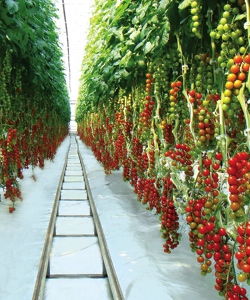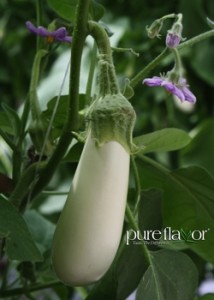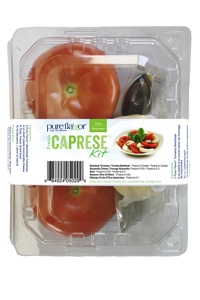
Good things growing
By Rebecca Harris
Business Operations Research & Development print issue - Food in CanadaCanada’s greenhouse sector is booming, as vegetable and fruit producers continually find ways to innovate
In the heart of the tomato capital of Canada, Pure Hothouse has an unlikely vegetable growing on the vine: baby eggplant. When the Leamington, Ont. company first commissioned its greenhouse grower, Five Star Farms, to grow baby eggplant in 2008, it started out with just one row. With steady growth in sales in this niche market, the company now has 2.5 acres of purple, graffiti and white baby eggplant.
It’s small potatoes compared to Pure Hothouse’s massive tomato, cucumber and pepper operation, but illustrates the company’s innovative mindset. Pure HotHouse trials 50 to 100 new varieties each season, with the goal of improving its existing products and finding new ones.
“We’re not afraid of testing several ideas to see if they’ll work in the marketplace,” says Jamie Moracci, president of Pure Hothouse, which markets and distributes its products under the Pure Flavor brand. “We understand that not everything we try will pan out, but it’s necessary to go through the steps in order to find new products that will give us an edge with retailers and consumers.”
Across the sector, new varieties, packaging and growing techniques are giving greenhouse products the edge over field-grown vegetables. In 2011, greenhouse vegetable sales exceeded sales of field vegetables for the fifth consecutive year, according to Statistics Canada. Total sales of greenhouse vegetables and fruit climbed to $1.1 billion in 2011, up from $800 million, or 38 per cent, from just four years prior. Ontario alone represented 63.3 per cent of greenhouse vegetable and fruit sales in 2011.
Chris Veillon, director of Marketing at Mastronardi Produce in Kingsville, Ont., says new and different products are the main factor driving growth in the greenhouse industry. For example, 15

Images this page of tomatoes from Kingsville, Ont.-based Mastronardi Produce, the largest greenhouse operator in North America.
years ago tomatoes came in one variety and consumers used them in everything from salads to sauces. “Now when you walk into a store, it’s an experience where you’re buying specific products for specific uses,” says Veillon. “Customers are becoming more savvy with the tomatoes they’re purchasing and how they’re using them.”
Mastronardi Produce, which began growing vegetables in the 1920s, is now the largest greenhouse operator in North America. It produces a wide range of gourmet greenhouse tomatoes, peppers and cucumbers under its Sunset brand, including Campari cocktail tomatoes, Spendido grape tomatoes and Zima, an orange grape tomato meant for snacking. “Our forte is in new product development,” says Veillon. “[We] test over 200 different varieties of tomatoes in every colour, shape and size you can think of.”
Some key consumer trends are also contributing to the vegetable greenhouse sector’s success. “There’s an increase in the population that’s interested in eating more healthy, and obviously all the products that we’re producing fit that need,” says George Gilvesy, general manager at Ontario Greenhouse Vegetable Growers (OGVG), a not-for-profit organization that represents 224 vegetable greenhouse operators in the province. And as the local food movement takes off, “we’re seeing a switch from consumers who are supporting and looking for [locally grown] products,” says Gilvesy.
OGVG works closely with major grocers on an Ontario government advisory committee that helps promote Ontario-grown greenhouse products. This past winter, for example, a marketing campaign promoted winter cucumbers in January and February. “[The goal] was to bring awareness to Ontario consumers that local, fresh greenhouse cucumbers were available even though the snow was flying,” says Gilvesy.
This summer, OGVG ran in-store demos in the eastern U.S. to educate consumers about Ontario English cucumbers. Though 70 per cent of Ontario greenhouse products are currently exported to the U.S., there’s still plenty of room to grow. “Some U.S. consumers are not that familiar with English cucumbers, and it gives us a great opportunity to promote the tasting, use and purchase of our products,” says Gilvesy.
For Pure Hothouse, the consumer trend towards convenience is a big opportunity to boost sales. In October 2012 the company launched a line of Fresh Kits that pair Pure Hothouse-grown products with other ingredients needed to create salsa, guacamole and Insalata Caprese. The packaging has recipe suggestions, breathable wrap and a recyclable tray. “It combines convenience and snacking in an innovative package, but it also involves collaboration with open-field growers to create a product that drives their sales,” says Moracci.
Greenhouse operators are also seeing a bright future with new growing techniques and technologies. Mastronardi is working with Phillips to trial an LED interlighting system at its Coldwater, Mich. facility, with the intention of growing tomatoes 12 months a year. The company’s EnviroFresh Farms in Courtright, Ont., is on the cutting-edge of green technology, utilizing waste steam and carbon dioxide from a neighbouring fertilizer company to grow produce. “We take the waste [steam] and CO2 out of this industrial facility and we pump into our greenhouse, which in turn makes our greenhouse carbon negative,” says Veillon.
Another quantum leap forward in vegetable greenhouses is the potential use of robotics to undertake tasks like harvesting. Vineland Research and Innovation Centre in Ontario’s Niagara region is developing robots that harvest and package mushrooms. The software that indicates what mushrooms to pick has already been developed, and Vineland is currently testing individual components of the robot, such as the gripper tool that grabs the mushroom. The aim of the technology is to alleviate both the cost of labour and challenges in labour supply.
“The biggest single issue in horticulture in Canada today is labour,” says Jim Brandle, CEO of Vineland Research and Innovation Centre. “While we

Pure Hothouse trials 50 to 100 new varieties of produce each year, developing innovative products like purple, graffiti and (shown here) white baby eggplant.
have programs that alleviate the labour supply problem, such as offshore labour programs, we don’t have programs that alleviate the cost of labour.” Brandle thinks there will be widespread adoption of robotics in the future. “We’ll try to make them accessible in the sense that the cost of the machines and the payback periods are such that everybody will be able to use them,” he says.
Though it’s unlikely that small growers will turn to robots, they too are faced with labour challenges. “It’s a big-time problem,” says Fred Gittings, who started Grandora Gardens in Saskatoon, Sask. in 1990. “If you can breathe in Saskatoon, you have a job. It’s boom time….We’re seeing the same thing Alberta did 10 years ago, where you can work at McDonald’s and make $15 an hour. It’s tough to get labour.” But the flip side, he adds, is that “everybody’s got money.”
Gittings, who sells tomatoes, cucumbers, peppers and lettuce directly to consumers, says while the labour shortage isn’t totally preventing his one-acre greenhouse from expanding, it is a hindrance. “It’s certainly something we have to be cognizant of because before we expand, we have to have good people.”
Despite the challenges in the sector, continued product innovation and increased demand for greenhouse-grown vegetables means the forecast is nothing but sunshine.
Print this page
